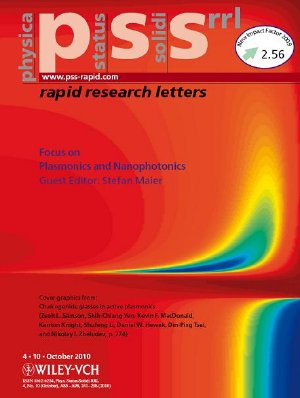The race towards fully integrated photonics is on, and plasmons, quantized plasma density fluctuations in solids, are the vehicle allowing photons to squeeze into nanoscale device structures. But set aside the huge drive these application prospects lend to the field - there is a wealth of intriguing and beautiful physics to explore.
“Plasmonics is rapidly developing into its own discipline at the boundaries of physics, materials science and chemistry, and leading the way towards a marriage between photonics and the nanosciences,” Stefan Maier says in the editorial of the latest issue of 'physica status solidi - Rapid Research Letters' (pss (RRL)), which is dedicated to this topic: 'Plasmonics and Nanophotonics'. Maier, acting as the guest editor of the issue, is convinced that plasmonics is at a very exciting point at the mo-ment, as our understanding of the electromagnetic properties of nanoscale systems is applied to more complex systems not only including metals, but also functional materials that change their properties due to external stimuli. New materials systems are attracting ever more attention, driven by the need to overcome the optical losses intrinsic to the most common plasmonic materials, gold and silver.

Stefan Maier, Co-Director of the Centre for Plasmonics & Metamaterials at Imperial College London, and his group are researching fundamental light/matter interactions on the nanoscale as well as applied design of metamaterials, now aspiring to integrated biological sensors. For his contributions on nanostructured optical metallic waveguides and on high confinement plasmon waveguiding in the THz regime, Meier has been honored with the Paterson medal and the Sackler Prize in Physics in 2010.
The focus issue, which will be freely accessible until January 31th 2011, comprises 19 invited, yet doubly peer-viewed papers representing a good spectrum of the variety of plas-monics research currently underway – from a strong focus on the basic properties of light localization on the nanoscale to hybrid systems with modulating functionalities and devices.
In the field of integrated surface plasmon (SP) nanophotonics, to communicate with densely integrated plasmonic components, there is a need for a compact structure for coupling to SPs, and a corresponding need for a method for determining the coupling efficiency of any such structures. In the focus issue, a research group from the University of Central Florida (Orlando, USA) presents their study of a nanoparticle enhanced grating coupler for exciting SPs on a nearby metal film. They developed a broadly applicable method to determine the absolute wavelength dependent coupling efficiency of the miniature coupler, and demonstrate the presence of both grating-mediated and particle resonance mediated SP excitation.
Another example for a topic the special issues deals with is the excitation of surface plasmons in nanoapertures, which results in large electromagnetic field enhancements useful for appli-cations such as surface enhanced Raman scattering (SERS). The enhancement factor strongly depends on the exact geometrical parameters. A three-dimensional numerical study carried out by Belgian scientists now indicates that the excitation of highly confined lateral Fabry–Pérot surface plasmon resonances results in enhancement factors greatly exceeding the two-dimensional, long-slit case. Therefore, they anticipate that devices like a special gold nanoslit-cavity they developed, are particularly interesting for investigating single molecules.
Regular arrays of metal nanoparticles on metal films have tuneable optical resonances that can be applied for SERS or biosensing. With the aim of developing more surface selective geometries, researchers from Graz (Austria) investigated regular gold nanoparticle arrays on 25 nm thick gold films, which enable excitation of asymmetric surface plasmon modes featuring a much better field confinement compared to the symmetric modes used in conventional surface plasmon resonance setups. They report on the identification of the plasmonic modes sustained by the structures and reveal the role of modifications in the crystalline structure of gold on the optical properties.